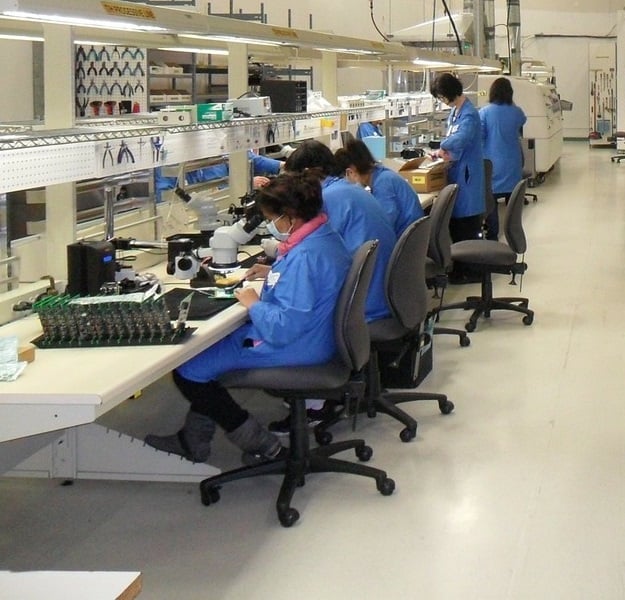Flying Probe PCB Testing: A Practical Guide to Reliable Results
There’s no perfect playbook to establishing and maintaining major transportation projects like subways, bus systems, and other transit developments.
5 min read
 Matric Group
:
Oct 02, 2019
Matric Group
:
Oct 02, 2019
 Modern electronics are evolving so rapidly that new becomes old in just a few years -- or less, if you’re an iPhone superfan. In fact, the average life of a new integrated circuit is less than 2 years.
Modern electronics are evolving so rapidly that new becomes old in just a few years -- or less, if you’re an iPhone superfan. In fact, the average life of a new integrated circuit is less than 2 years.
This can be exciting for consumers, but for OEMs of electronic products, failure to keep up can spell doom. More than ever, the integrity of your product’s life cycle relies on obsolescence management.
Here are the obsolescence management procedures you and your contract manufacturer should take. With these expectations in place, you’ll keep old stuff alive longer and make new stuff that’s built to last!
Obsolescence management services should be comprehensive, whether you’re doing them yourself or outsourcing to an ECM (electronics contract manufacturer). Best practices include:
The best way to succeed with forecasting is to make sure the customer/supplier communication channel is open at all times.
If you tell your contract manufacturer, “OK, we are expecting to ramp up or wind down production,” it can assess whether or not it can meet demand. Similarly, if you’re eyeing a last-time buy … you need to make sure the ECM can make that big investment with you.
While cycling out the old for the new, you’ll want to be protected. One way to do this is an NCNR (noncancelable, nonreturnable) order.
Last-time buys and NCNRs can be critical to clearing regulations and getting your product to market. Mining applications or medical devices can easily take a year to go through approval -- best to make that process as smooth as possible.
Inventory marked as NCNR is fairly standard in the industry, but not every ECM will take this on for you -- it ties up cash. Some other companies might only accept 50% of them. In other cases they’ll store NCNR parts for you in-house, but they’re your property.
Try whenever possible to work with an ECM that has the financial stability to manage NCNR situations to the fullest extent.
Examples: Say a customer has a demand for 100 units that it thinks might increase to 500 units someday. The customer doesn’t have the authority to execute a purchase order for 500, because once they execute that, it’s a binding contract.
A way to limit risk and investment is with NCNR orders. Matric, for example, looks at the last-time buy items on the bill of materials (BOM). We’ll go buy the 500, carry that cash burden, and source it.
It’s a great way to tighten the ECM/supplier relationship.
If you don’t use all 500 parts, you buy them from us. But you don’t have to execute a purchase order for the BOM -- win-win.
If you’re running into long lead times due to obsolescence, you need to be mindful of your inventory flow.
It’s inevitable that when you come to an end of life cycle of a component, you'll be looking to do one of two things:
You don't want to be stuck with unpopulated boards that you can't fill. Conversely, you don’t want to redo the board from scratch because it’s no longer usable.
In this way, component inventory management works hand in hand with engineering.
Examples: Say a customer has a single obsolete part it’s been working around. Or maybe 10% of their board is obsolete.
During engineering, the ECM must be mindful of the status of the components it has on hand. The replacement part must also be checked to ensure it isn’t obsolete or facing last-time buy.
Obsolescence isn’t a one-size-fits-all operation, especially when it comes to engineering.
Some customers expect their ECM to help with lifecycle management. They want to hear quickly and clearly from the contractor when a component on their PCB is going obsolete.
It’s good practice to entrust that side of sourcing to the contractor. You’ll get a timely heads-up, your engineering team can look at the issue, and the ECM gets to work solving the problem. The contractor will consider either doing an NCNR order or finding something available it can buy.
If you can’t find a certain part, the ECM should help you find an alternative that’s as cost-effective as possible without impacting performance.
Examples:
It all depends on what your vision is for your product in the marketplace. How attentive do you want to be? Or do you want to limp along until the next generation?
Work with an electronics contract manufacturer that gives feedback where there are issues with sourcing. An open dialogue with the ECM’s engineering team will help your own engineers understand how to build your product going forward.
No one’s got enough time in the day to look up everything on the bill of materials.
All the major component manufacturers these days have giant distribution email lists these days. Someone in there, you’ll find a list of parts that are going obsolete, along with potential alternatives.
We recommend consolidating all that into a third-party electronics component database, or working with an ECM who does. Software like SiliconExpert collects all that manufacturer data into a single, regularly updated database. No need to hunt for that info all day.
Once you or your ECM uploads the bill of materials into the database, you’ll get an alert if an obsolete (or almost-obsolete) component is on the assembly.
Examples: An electronics product maker may face any of these three alerts:
Looking for obsolescence management services? When you’re picking a manufacturing partner, tell them you’re concerned about component obsolescence and want added protection.
To review: If you’ve found yourself in any of these situations before, you need the comfort of obsolescence management:
Matric and Dynamic can help you through all stages of product life cycle. With our help, you can optimize a new design for the market. If you really want to keep old parts chugging along from an aftermarket service perspective, we’ll help you there too.
What are your obsolescence challenges? Click below to tell us -- we’ll directly assess your strategy.
 Interested in learning more about obsolescence and aftermarket services? Check out the recording of our recent webinar, Understanding Remanufacturing & Aftermarket Services.
Interested in learning more about obsolescence and aftermarket services? Check out the recording of our recent webinar, Understanding Remanufacturing & Aftermarket Services.

There’s no perfect playbook to establishing and maintaining major transportation projects like subways, bus systems, and other transit developments.

You just installed your new PCBs in your machines and they’re working great! Dust off your hands and pat yourself on the back; the hard part’s done,...

Consolidating services is a great way to reduce costs, lead times, & confusion. Unfortunately, most electronics contract manufacturers (ECMs) don’t...